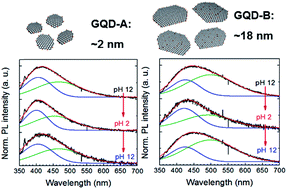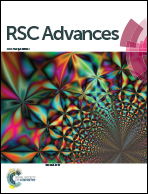Size and pH dependent photoluminescence of graphene quantum dots with low oxygen content†
Abstract
The photoluminescence of graphene quantum dots (GQDs) is rigorously investigated due to their potential applications. However, GQDs from graphene oxide are inherently embedded with non-negligible defects and oxygen grafted onto the edge and basal plane, which induce a change of innate electronic structure in the GQDs. Thus, graphene oxide based GQDs can misrepresent the characteristic properties of primitive GQDs. Here we report the size and pH dependent photophysical properties of GQDs that minimize the content of oxygen and defects. From auger electron spectroscopy, the oxygen content of the GQDs with two different lateral sizes (∼2 nm and ∼18 nm) was probed and found to be ∼5% and ∼8%, respectively. Two common photoluminescence (PL) peaks were observed at 436 nm (the intrinsic bandgap) and 487 nm (the extrinsic bandgap) for both GQDs. The characteristic PL properties in extrinsic and intrinsic bandgaps examined by optical spectroscopic methods show that the emission peak was red-shifted and that the peak width was widened as the size increased. Moreover, the PL lifetime and intensity were not only reversibly changed by pH but also depended on the excitation wavelength. This is in line with our previous report and is ascribed to the size variation of sp2 subdomains and edge functionalization.



 Please wait while we load your content...
Please wait while we load your content...